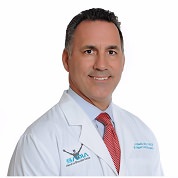Hand and Upper Limb Surgeon Dr. Alejandro Badia Says Surgery ‘Last Resort’, Offers Education, Tips.
MIAMI (PRWEB) April 08, 2020
How best to repair the labrum, a cartilage structure that deepens the socket of the shoulder joint, remains somewhat controversial, but technological advances, including knotless sutures and bioabsorbable tissue anchors, are greatly improving outcomes for patients who require surgery, says noted hand and upper limb orthopedic surgeon Alejandro Badia MD.
In fact, Dr. Badia reports significant clinical success in performing minimally invasive, arthroscopic surgery, proving particularly beneficial for closing SLAP tears, namely injuries to the upper portion of the labrum, the fibrous cartilage that surrounds the rim of the shoulder socket or glenoid socket.
The knotless sutures loaded onto bioabsorbable anchors are used to reattach the detached labral tissue at the right tension to return the shoulder joint to full movement. Dr. Badia, a specialist in treating musculoskeletal disorders of the upper limbs, including shoulder, says the knotless systems remove the risk of irritating the shoulder shoulder-joint and also allow for better control of the tension during the repair. “The repair of a labral tear/detachment is now done ALL arthroscopically: via 3 small portal incisions as seen HERE,” says Dr. Badia.
The labrum serves to helps stabilize the head of the humerus in the head of its socket, the glenoid, whereas the rotator cuff tendons primarily role is to maintain the head within that socket allowing shoulder motion. Tears in the labrum can be caused by trauma, such as sports-related injuries; repetitive use of the shoulder by athletes and workers for lifting, catching or the overhead throwing of heavy objects; and simple weakening due to aging, Dr. Badia says.
A common cause of a labral injury occurs when a person instinctively outstretches the arms in an effort to break a fall. Falling directly on the shoulder can also tear the labrum by causing a dislocation of the shoulder joint.
The shoulder is highly vulnerable to disease and injury because it is the most unstable joint in the body, explains Dr, Badia, who is founder and medical director of the Badia Hand to Shoulder Center and OrthoNOW®. “Yet, it is this very instability that provides the shoulder with such an extensive range of motion, allowing it to assume up to 1,000 different positions.”
Patients with labral tears may complain of non-specific pain and sensitivity in the front of the shoulder, shoulder popping and a general sense of instability in the joint – symptoms that oftentimes make diagnosis difficult. Labral tears are hard to prevent as they tend to be from sports related or traumatic injury events. “Shoulder pain is one of the most common musculoskeletal complaints of patients but pinpointing the precise nature of the problem can be challenging and should be done by an orthopedic specialist experienced in treating disorders of the upper limbs,” Dr. Badia states.
Labral tears are a common cause of persistent shoulder pain and difficult to diagnose even by MRI. In fact, many times the diagnosis is made at the time of the arthroscopy, where a fiber optic instrument is inserted into the shoulder allowing diagnosis and definitive repair during that same out patient procedure. However occasional failed labral repairs can be due to ineffective or incorrect suture anchor placement and over-tensioning of the labrum tissue and biceps tendon. Patients are encouraged to seek out experienced shoulder specialist.
Dr. Badia concurs but points to a recent study, published in Arthroscopy Techniques, in which researchers stress how refinements in arthroscopic surgery, including use of “knotless suture anchor techniques” for labral tissue repairs of the shoulder have led to more favorable treatment outcomes, especially in instances of type II SLAP injuries.
The authors write: “Arthroscopic knotless techniques for treating labral tears of the shoulder have experienced a continual evolution. Like any innovation in the field of arthroscopy, acceptance takes time and attestation before becoming the gold standard for operative management.”
Meanwhile, Dr. Badia emphasizes conservative approaches can be initially used with small labral tears including cryotherapy, anti-inflammatory medications, rehabilitation and perhaps injection of certain orthobio agents, such as PRP.
“Surgery should only be performed if rest and rehabilitation are unsuccessful in healing the injury,” he adds. “Any operation should be performed not only to repair the labral tissue but address the injury that resulted in the tear in the first place.”
Of course, preserving the health of the shoulder joint is preferable to either “long rehabilitation” or surgery. That’s why Dr. Badia offers these injury-prevention tips:
- Gently exercise and stretch shoulder muscles before exercising, engaging in sports or undertaking strenuous activity, especially overhead lifting, throwing or hitting.
- Take frequent breaks. If possible, discontinue an activity if a shoulder is becoming stiff or sore.
- Practice good posture while standing or sitting
- Follow the cautionary rules for lifting heavy objects safely
- Don’t overreach for objects, particularly overhead items that are high off the floor.
- Contact an orthopedic specialist who is well versed in the shoulder should unusual, long-lasting joint pain develop.
Alejandro Badia, MD, FACS, internationally renowned hand and upper-limb surgeon and founder of Badia Hand to Shoulder Center and OrthoNOW®, a walk-in orthopedic care clinic. Dr. Badia specializes in treating all problems related to the hand and upper extremities, including trauma, sports injury, joint reconstruction, nerve injuries and arthroscopic surgeries. Go to OrthoNOWcare.com and drbadia.com.

